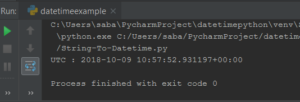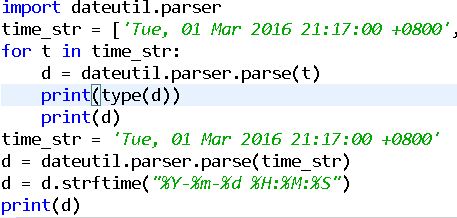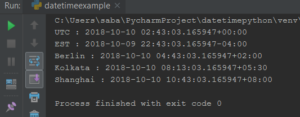
- #Python convert string to datetime with t and z how to
- #Python convert string to datetime with t and z code
- #Python convert string to datetime with t and z iso
- #Python convert string to datetime with t and z windows
# Note: returned value is your local time zone. # Takes a string of the time in ISO8601 (UTC) format, # Takes a string of the time in ISO8601 format, StrKv = strKv + (seconds).strftime('%H:%M:%S') # and returns a string of the time in ISO8601 format. Here is a super simple way to do these kind of conversions. Output_datetime = output_datetime + offset_delta
#Python convert string to datetime with t and z code
date datetime.strptime(datestring, format) print(date) Let's go over the above code again to make sure we understand what's going on. Offset_delta = datetime.timedelta(hours=int(sign+offset), minutes=int(sign+offset)) We can do that by typing the following: from datetime import datetime datestring '9' format Y/m/d specifify the format of the datestring. A date in Python is not a data type of its own, but we can import a module named datetime to work with dates as date objects. Output_datetime = (main_timestamp +"Z", "%Y%m%dT%H%M%S.%fZ" ) # Generate the datetime object without the offset at UTC time Split_timestamp = re.split(r"()",conformed_timestamp) Use a capture group to keep the delimiter # dashes EXCEPT for the dash indicating + or - utc offset for the timezoneĬonformed_timestamp = re.sub(r"|((?!((\d))$))", '', timestamp) These will convert all variations into something without variable delimiters like 20080903T205635.450686+0500 making it more consistent/easier to parse. If you just want a basic case that work for UTC with the Z suffix like T19:36:29.3453Z: (anslate(None, ':-'), "%Y%m%dT%H%M%S.%fZ") The goal is to generate a UTC datetime object. If you want to use strptime, you need to strip out those variations first.
#Python convert string to datetime with t and z iso
strftime() method.Because ISO 8601 allows many variations of optional colons and dashes being present, basically CCYY-MM-DDThh:mm:ss. The following is an example code, to ISO date in string format using the. Here as we know that ISO format is YYYY-MM-DD so we convert it into this format by using the following format code- “%Y-%m-%dT%H:%M:%S.%f%z”.

Python3 import datetime tz.tzutc ().utcoffset ( ()) datetime.timedelta (0) Pass in a timezone file path to the gettz () function to get tzinfo objects for other timezones. This string is converted into an ISO format string by using the. tzutc () The offset is 0 by calling the utcoffset () method with a UTC datetime object. In this method, we get the current date and time from the local CPU by using the datetime.now() method. Where, format is used to specify the required format of the output. The syntax of strftime() is described below. We use time.gmtime(0) to get the epoch on a given platform.
#Python convert string to datetime with t and z windows
The epoch is January 1, 1970, 00:00:00 (UTC) on Windows and most Unix systems, and leap seconds are not included in the time in seconds since the epoch. It is also used to convert datetime to epoch.Įpoch is the starting point of time and is platform-dependent.

Yours are probably nanoseconds, as f only takes maximum of 6 digits. BUT they would then need to be microseconds. Here we use the strftime() method to convert a string datetime to datetime. t datetime.strptime(s, 'Y-m-dTH:M:S.fZ') would be the correct format string as you have fractions of second as well. The strftime() method is provided by the datetime module in python. The output of the above code is as follows. In this example code, we get an ISO 8601 date in string format using the. This string is then converted into the ISO format by using the. In this method, we get the current datetime string by using the datetime.now() method which returns the current date and time in time format.

Timespec(Optional parameter) − It is the format specifier for timespec. Python Program to Convert String to DateTime Examples: Input : 10:07AM Output : 10:07:00 Input : 5:30PM Output : 17:30:00 Using datetime.strptime () function The strptime () is available in DateTime and time modules and is used for Date-Time Conversion. Sep(Optional parameter) − It is a separator character that is to be printed between the date and time fields. isoformat() method returns a string of date and time values of a python datetime.date object in ISO 8601 format. import datetime ().replace(tzinfoNone). datetime.UTC Alias for the UTC timezone singleton.
#Python convert string to datetime with t and z how to
In this article, we will discuss how to get an ISO 8601 date in string format in python. Here's how to get the current UTC time and convert to the ISO-8601 format (which is what your example shows). datetime.MAXYEAR The largest year number allowed in a date or datetime object. While date and time arithmetic is supported, the focus.

To tackle this uncertainty of various formats ISO sets a format to represent dates “YYYY-MM-DD”.įor example, May 31, 2022, is represented as. Source code: Lib/datetime.py The datetime module supplies classes for manipulating dates and times. ISO 8601 is a date and time format which helps to remove different forms of the day, date, and time conventions across the world. The ISO 8601 standard defines an internationally recognized format for representing dates and times.


 0 kommentar(er)
0 kommentar(er)
